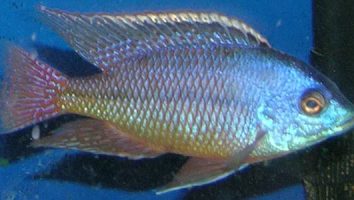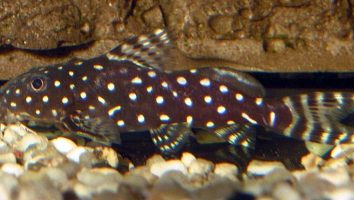Denison’s barbs are a schooling fish that originates from the rivers of India.
They’re a beautiful and peaceful fish that’s perfect for beginners, and they’re one of our personal favorites.
But even though they’re easy to care for, there’s still a lot you need to know before you get them.
In this guide, we’ll teach you everything you need to know about Denison’s barb care. Tank size, diet, tank mates, and more.
Table of contents
Species overview
Denison’s barbs (scientific name: Puntius denisonii) are a freshwater fish that’s native to Sri Lanka and southern India.
They prefer slow-moving rivers and streams with a lot of vegetation. This is something that’s common among many fish species from this region of the world.
Denison’s barbs are a schooling fish, which means they like to live in groups. In the wild, these groups can sometimes number in the hundreds!
They are a peaceful fish but can be territorial toward their own species. This is something to keep in mind if you’re thinking about adding more than one Denison’s barb to your aquarium.
These fish are very popular in the aquarium scene because of their beautiful coloration. They are a silver color with black stripes running along their body.
Appearance

The most notable thing about Denison’s barbs is their coloration. The base color of these fish is a beautiful golden yellow.
This color is then accented by a black stripe that runs down the center of their body (from their mouth to their caudal peduncle). This stripe is bordered by a thin line of white.
The fins on Denison’s barbs are also pretty striking. The dorsal fin is tall and triangular in shape. It starts about halfway back on the body and extends almost to the tail.
The anal fin is also tall and triangular but starts closer to the tail. Both of these fins have a black stripe down the center with white borders.
The caudal fin is forked and symmetrical. The ventral and pectoral fins are also black with white borders.
Denison’s barbs are fairly small fish, only growing to be about 3-4 inches in length.
Lifespan
Denison’s barbs are relatively long-lived fish, with a lifespan of up to 15 years in captivity.
As with all fish, the lifespan of Denison’s barbs can be affected by a number of factors, including water quality, diet, and stress levels.
Providing them with a good quality of life will obviously help them to live longer, so it’s important to do your research before getting these fish.
Size
Denison’s barbs can grow up to around 4 inches (10 cm) in length.
Tank
Tank Size
A single Denison’s barb can be kept in a 20 gallon tank, but we recommend going up to a 30 gallon tank if you have the space. This will give the fish room to swim and provide a little more stability to the water quality.
If you’re looking to keep a school of Denison’s barbs, we recommend a 50 gallon tank as the minimum. This will give the fish plenty of space to swim and establish their own territories.
Water Parameters
As with all fish, it’s important to maintain proper water parameters to ensure a healthy and stress-free environment. Denison’s barbs are no different. These fish are native to the flowing waters of Southeast Asia. In the wild, they inhabit fast-moving rivers with little to no vegetation.
To replicate these conditions in the home aquarium, you’ll need to maintain the following water parameters.
- Water Temperature: 70 to 80 degrees Fahrenheit
- pH Levels: 6.5 to 7.5
- Water Hardness: 5 to 15 dGH
- Alkalinity Levels: 3 to 8 dKH
What To Put In Their Tank
Denison’s barbs are a schooling fish, so it’s important to keep that in mind when setting up their habitat.
A lot of the same general principles apply here as they do with other fish. You want to create a space that’s comfortable and safe for them to swim around in.
One of the best ways to do this is by including a lot of hiding spots. This can be in the form of plants, rocks, or driftwood. The more the better!
We also recommend a fine gravel substrate. This will help keep the water clean and give the fish a little something to play with (they love to sift through the gravel).
Common Diseases
Denison’s barbs are a hardy and relatively disease-resistant fish. However, they are not immune to all illnesses. The most common disease that these fish experience is ich.
Ich is a very common parasite that can become quite serious if it’s not dealt with. The most obvious sign of this disease is the series of white spots that will begin to cover the body of your fish.
If you notice this, it’s important to act fast. There are plenty of ich treatments available, but the sooner you start the treatment the better.
Other potential diseases include things like fungal infections, bacterial infections, and parasites. These are all relatively rare in Denison’s barbs, but they can still happen from time to time.
The best way to prevent your fish from getting sick is to maintain the quality of the water in their tank. A tank with clean and stable water conditions always leads to healthier fish who are more resistant to disease.
Behavior & Temperament
The Denison’s barb is a peaceful and relatively shy fish. It does best in a tank with plenty of hiding places, and it will often spend most of its time hiding among plants or other decorations.
Denison’s barbs are schooling fish, so they should be kept in groups of at least six. When they are in a group, they are much more active and will often swim in the middle or upper levels of the tank. They are also more likely to come out and explore their environment when they are in a group.
Denison’s barbs are not aggressive, but they can be nippy. They may nip at the fins of other fish, so they should not be kept with fish that have long fins. They are also known to nibble on live plants.
Tank Mates
Denison’s barbs are peaceful fish that do well in community tanks. They’re not aggressive and won’t bother other tank mates.
In fact, these fish do best in groups of six or more. This is because they’re social creatures that like to stick together.
When it comes to finding compatible tank mates, the sky’s the limit. These fish are adaptable and can thrive in a wide range of water conditions.
Here are a few compatible species to get you started:
- Tetras
- Guppies
- Mollies
- Platies
- Swordtails
- Rainbows
- Danios
Breeding
Breeding Denison’s barbs is not an easy task. These fish are very difficult to sex and even harder to get to spawn. If you’re up for the challenge, here’s what you need to know.
The first step is sexing the fish. This is no easy task, as males and females look nearly identical. The best way to tell them apart is by looking at the fins. Males have longer and more pointed fins.
Once you’ve managed to sex the fish, you’ll need to set up a breeding tank. The tank should be at least 30 gallons and filled with soft, acidic water. live plants are a must.
Add a few pieces of driftwood for the females to lay their eggs on. Then, add a sponge filter to keep the water clean.
When everything is ready, add two females for every male. The fish will likely ignore each other at first, but eventually they’ll start to breed.
The female will lay her eggs on the driftwood, and the male will fertilize them. Once that’s done, the male will guard the eggs until they hatch.
After the eggs have hatched, you’ll need to remove the adults and begin feeding the fry live foods. Brine shrimp and daphnia are a good choice.
As the fry grow, you can slowly start to introduce them to dry foods.
Conclusion
The Denison’s barb is a great fish for beginner aquarists. They are relatively easy to care for and are very active fish. They are also very peaceful, which makes them a great addition to community tanks.
The only downside to this fish is that they can be a little nippy. But, as long as you have a good understanding of their care requirements, we think you’ll be just fine.
Overall, we think the Denison’s barb is a great fish for beginner aquarists and would highly recommend them to anyone looking to add a little excitement to their tank.












